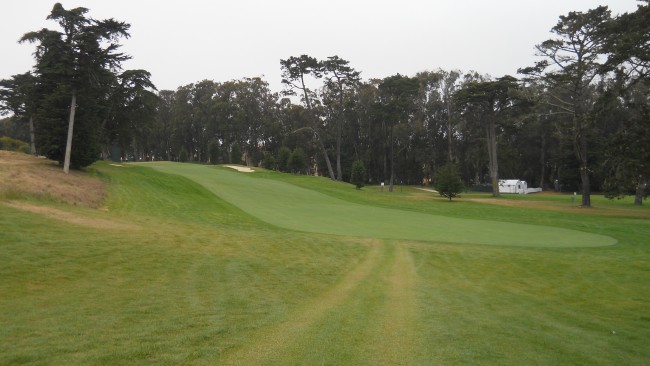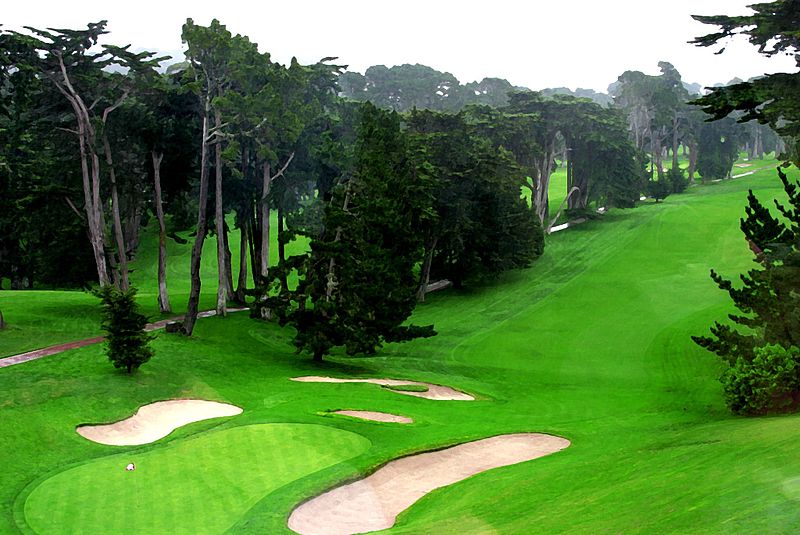The USGA announced last week that San Francisco’s hallowed The Olympic Club Lake Course will host its first U.S. Women’s Open in 2021.
Site of 11 previous USGA championships, including five U.S. Opens in the last 60 years, The Olympic Club’s devastating combination of length, trees and reverse camber should provide one of the sternest tests the women should have ever seen for their National Open.
“There’s only one bunker, but 40,000 trees,” quipped quintessential Bay Area sports writer Art Spander, in an earlier interview. “No water…no O.B., just trees, trees, trees, trees, trees…that and reverse camber.”
Spander’s analysis is laser-sharp: On a plot of land roughly the shape of a slightly-deflated football, the Lake Course features holes that turn one way, while the fairways slope in the opposite direction. The reverse camber and hanging lies are a great equalizer, wreaking havoc on a golfer’s psyche by requiring strategic planning and pinpoint execution on every shot.

“The topography at Olympic Club requires that you consider what will happen to the ball after it hits the fairway and runs along the ground,” explained Bill Love, the golf architect who prepared the Lake Course for the 2012 U.S. Open won by Webb Simpson. “You must place the tee shots well, or they may run through the fairway into a deep swale or end up behind a tree.”
“You don’t overpower Olympic, even if you’re long,” added 1964 U.S. Open winner Ken Venturi in a prior interview.
Most courses on the PGA Tour you can attack like an action hero jumping through a skylight with a machine gun. At The Olympic Club, you have to plan your way around like an architect designing a skyscraper. Elevated greens, shaved chipping swales for the green surrounds and uneven lies on the fast and firm fairways mean the ball tends to roll away from the target, putting a premium on accuracy and course management. Olympic requires accuracy and distance control.
As such, Olympic Club has been a graveyard for the game’s biggest stars, while several lesser-known players became national champions. Look at this list of winners, plodders and course managers all, and the Pantheon of legends they defeated:
- 2012 – Webb Simpson (1 major win) over Jim Furyk (1) and Graeme MacDowell (1)
- 1998 – Lee Janzen (2) over Payne Stewert (3)
- 1987 – Scott Simpson (1) over Tom Watson (8)
- 1966 – Billy Casper (3) over Arnold Palmer (6)
- 1955 – Jack Fleck (1) over Ben Hogan (9, 10 if you count like Dan Jenkins)
Total number of major championship wins by Olympic Club winners: 8
Total number of major victories by Olympic Club runners-up: 28
“The wrong guy always wins at Olympic Club,” joked golf writer Dan Jenkins. “The place hates sports writers!”
“If Olympic Club were a Grateful Dead song, it’d be ‘Feel Like a Stranger,’” added golf expert Bruce Moulton.
Now the stars of the LPGA get their turn on one of American golf’s most historic, celebrated and difficult venues, much like they did at Oakmont (2010 and 1992), Winged Foot (1972), Cherry Hills (2005) and Pinehurst (2014). If history is any indication, however, the USGA should give the ladies a bit of a break. While the U.S. Open is typically “Golf’s Toughest Test” (and under USGA head Mike Davis “Golf’s Fairest Toughest Test…”), since 1999 only once has the U.S. Women’s Open champion finished over par for the 72 holes – Birdie Kim at 3 over at Cherry Hills. Take Oakmont, for example. Angel Cabrera grinded to a 5-over winning score in 2007, but just three years later, Paula Creamer cruised to the title with a breezy 3-under total.
The key to mastering The Olympic Club is to survive the opening six holes – all murderously long - and then thrive on the score-able-but-dangerous closing four holes.
“Any player who finishes those first six holes at 2 over will be doing very well,” said Mike Davis at the pre-2012 U.S. Open media day, describing the five par 4s that played 520, 428, 438, 488 and 491 yards, and the 247 yard par-3 third hole. (The field average the first two days of the tournament was +2.43, slightly easier than Davis expected. However it is widely expected that the women will play the 500-plus-yard opening hole as a par 5.)
Likewise, the 17th will also play as a par 5, though occasionally it played as a long par 4 for the men. Indeed, the back-to-back par 5s at 16 and 17 may be ultra-dramatic as – along with the tiny par-3 15th, perhaps as short as 120 yards – players may get to go on a late birdie run and skyrocket up the leaderboard at the end of the day.
So at the end of the day, you can’t really ask for more from a major championship venue: The beginning is a grind, but the end is electric. There’s history, beauty, strategy and a big silver trophy waiting for a beaming champion. And if all goes as expected, watch closely for a return for another U.S. Open in the near future.
“Oly is one of those courses that’s so perfect for an Open, you could play there on short notice in an emergency…and no one would mind because it’s a sterling venue, and a nail-biter of a finish every time,” concluded Moulton. “There’s many reasons why they keep coming back here for the biggest events.”

